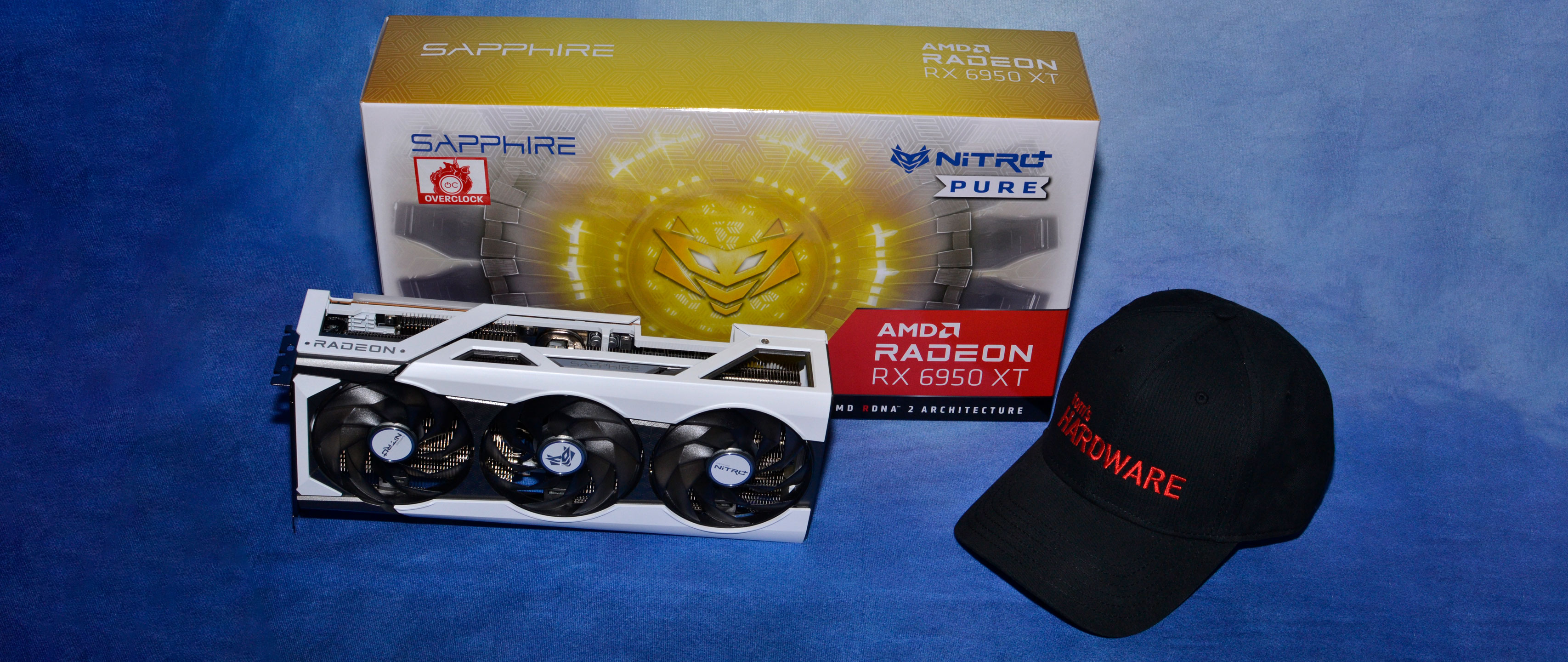Tom's Hardware Verdict
The Sapphire RX 6950 XT Nitro+ Pure boasts some of the fastest non-ray tracing results we've ever seen. Technically the RTX 3090 Ti still wins at 4K ultra, but 1080p and 1440p go to AMD, for a bit more than half the cost of Nvidia's latest tour de force. The main drawback is that AMD's RDNA 3 architecture should arrive before the end of the year, providing even better performance and features.
Pros
- +
Great non-ray tracing performance
- +
Affordable compared to Nvidia cards
- +
Reasonably efficient
Cons
- -
AMD RDNA 3 and Nvidia Ada are coming
- -
Not a major upgrade from an RX 6900 XT
- -
Sapphire card needs lots of room
Why you can trust Tom's Hardware
After numerous leaks and rumors, the AMD Radeon RX 6950 XT has arrived, accompanied by the Radeon RX 6750 XT and RX 6650 XT. With faster memory, higher GPU clocks, and a modest increase in power consumption, AMD's fastest can go toe-to-toe with Nvidia's fastest and come out with some key wins. 4K and ray tracing still favor Nvidia, but at nearly twice the cost, it's difficult to justify moving up to the RTX 3090 Ti. Nevertheless, for anyone who wants maximum AMD performance, the 6950 XT ranks as the best graphics card from Team Red and even takes over the top position in our GPU benchmarks hierarchy, at least for the traditional ranking.
AMD didn't provide samples of its new cards, unfortunately, and despite our best efforts, we were only able to procure the RX 6950 XT prior to launch — thanks to Sapphire. We'll have RX 6750 XT and RX 6650 XT reviews in the near future, and we already have an Asus RX 6750 XT in hand (it arrived yesterday, but testing isn't complete yet). As with Nvidia's RTX 3090 Ti launch, that means we'll be using factory overclocked cards, which is probably fine as that's what most people will be buying anyway. Here's the breakdown of the specs for the top AMD and Nvidia GPUs, plus the other two new AMD offerings.
| Graphics Card | RX 6950 XT Sapphire | RX 6950 XT | RTX 3090 Ti | RX 6750 XT | RX 6650 XT |
|---|---|---|---|---|---|
| Architecture | Navi 21 | Navi 21 | GA102 | Navi 22 | Navi 23 |
| Process Technology | TSMC N7 | TSMC N7 | Samsung 8N | TSMC N7 | TSMC N7 |
| Transistors (Billion) | 26.8 | 26.8 | 28.3 | 17.2 | 11.1 |
| Die size (mm^2) | 519 | 519 | 628.4 | 336 | 237 |
| SMs / CUs | 80 | 80 | 84 | 40 | 32 |
| GPU Cores | 5120 | 5120 | 10752 | 2560 | 2048 |
| Tensor Cores | N/A | N/A | 336 | N/A | N/A |
| Ray Tracing Cores | 80 | 80 | 84 | 40 | 32 |
| Boost Clock (MHz) | 2435 | 2310 | 1860 | 2600 | 2635 |
| VRAM Speed (Gbps) | 18 | 18 | 21 | 18 | 18 |
| VRAM (GB) | 16 | 16 | 24 | 12 | 8 |
| VRAM Bus Width | 256 | 256 | 384 | 192 | 128 |
| ROPs | 128 | 128 | 112 | 64 | 64 |
| TMUs | 320 | 320 | 336 | 160 | 128 |
| TFLOPS FP32 (Boost) | 24.9 | 23.7 | 40 | 13.3 | 10.8 |
| TFLOPS FP16 (Tensor) | N/A | N/A | 160 (320) | N/A | N/A |
| Bandwidth (GBps) | 576 | 576 | 1008 | 432 | 288 |
| TDP (watts) | ~370? | 335 | 450 | 250 | 180 |
| Launch Date | May-22 | May-22 | Mar-22 | May-22 | May-22 |
| Launch Price | $1,249 | $1,099 | $1,999 | $549 | $399 |
AMD's three new models take the existing Navi 21, 22, and 23 GPUs in their maximum configurations and add in 18 Gbps GDDR6 memory, slightly higher power levels, and increased prices. The RX 6900 XT and RX 6700 XT will apparently continue to be sold alongside the newcomers, while the RX 6600 XT will be phased out and the RX 6650 XT will be the sole replacement. AMD hasn't announced any official price changes to the 6900 or 6700 cards yet, though we've seen the RX 6900 XT selling for as little as $900 (after a $50 rebate) in the past week.
It will be interesting to see how retail pricing changes over the coming months, as many graphics card manufacturers still seem to be caught in 2021 thinking. AMD initially gave a target price of $1299 for the 6950 XT but dropped that to $1,099 a few days later, probably due to feedback from the press it briefed. Nvidia's stratospheric pricing on the 3090 Ti might make AMD's prices look at least somewhat reasonable, but practically speaking, the 6950 would have likely been a $700–$800 card in the pre-pandemic days.
Sapphire's 6950 XT Nitro+ Pure tacks on another $150 to the reference pricing but also increases the boost clock by about 5% and adds in plenty of bling for good measure. On paper, the reference 6950 XT has 12.5% more memory bandwidth than the reference 6900 XT, while the Game Clock is only 85MHz higher (2100MHz vs. 2015MHz). That's a small 4.2% improvement in theoretical clock speeds, but as we'll see later, the factory overclocked Sapphire card tends to clock much higher than the listed Game Clock and even the Boost Clock.
The higher power limit also comes into play, and while Sapphire didn't specify an official TBP (Typical Board Power) and only gave TGP (Total Graphics Power, which only measures the power consumed by the main GPU chip), all told we'd expect performance to be about 10% than the 6900 XT. As we'll see in a moment, that's often the case but there are occasions where the 6950 XT delivers much higher performance.
- MORE: Best Graphics Cards
- MORE: GPU Benchmarks and Hierarchy
- MORE: All Graphics Content
Get Tom's Hardware's best news and in-depth reviews, straight to your inbox.
Current page: Intro and Specifications
Next Page Sapphire Radeon RX 6950 XT Nitro+ Pure
Jarred Walton is a senior editor at Tom's Hardware focusing on everything GPU. He has been working as a tech journalist since 2004, writing for AnandTech, Maximum PC, and PC Gamer. From the first S3 Virge '3D decelerators' to today's GPUs, Jarred keeps up with all the latest graphics trends and is the one to ask about game performance.

